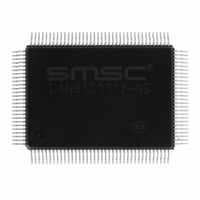LAN91C111I-NS SMSC, LAN91C111I-NS Datasheet - Page 21

LAN91C111I-NS
Manufacturer Part Number
LAN91C111I-NS
Description
IC ETHERNET CTLR MAC PHY 128-QFP
Manufacturer
SMSC
Type
Single Chip MAC and PHYr
Datasheet
1.LAN91C111-NU.pdf
(128 pages)
Specifications of LAN91C111I-NS
Controller Type
Ethernet Controller, MAC/PHY
Interface
Serial EEPROM
Voltage - Supply
3.3V
Operating Temperature
-40°C ~ 85°C
Mounting Type
Surface Mount
Package / Case
128-QFP
Product
Ethernet Controllers
Number Of Transceivers
1
Standard Supported
IEEE 802.3 or IEEE 802.3u
Data Rate
10 Mbps or 100 Mbps
Supply Voltage (max)
5 V
Supply Voltage (min)
0 V
Supply Current (max)
140 mA
Maximum Operating Temperature
+ 85 C
Ethernet Connection Type
100BASE-T or 100BASE-T4 or 100BASE-TX or 10BASE-T
Minimum Operating Temperature
- 40 C
Mounting Style
SMD/SMT
Lead Free Status / RoHS Status
Lead free / RoHS Compliant
Current - Supply
-
Lead Free Status / Rohs Status
Lead free / RoHS Compliant
Other names
638-1014
Available stocks
Company
Part Number
Manufacturer
Quantity
Price
Company:
Part Number:
LAN91C111I-NS
Manufacturer:
RECOM
Quantity:
1 000
Company:
Part Number:
LAN91C111I-NS
Manufacturer:
SMSC
Quantity:
1 000
Company:
Part Number:
LAN91C111I-NS
Manufacturer:
Standard
Quantity:
6 916
Company:
Part Number:
LAN91C111I-NS
Manufacturer:
Microchip Technology
Quantity:
10 000
10/100 Non-PCI Ethernet Single Chip MAC + PHY
Datasheet
SMSC LAN91C111 REV C
7.4
7.5
7.5.1
BIU Block
MAC-PHY Interface
The Bus Interface Unit can handle synchronous as well as asynchronous buses; different signals are
used for each one. Transparent latches are added on the address path using rising nADS for latching.
When working with an asynchronous bus like ISA, the read and write operations are controlled by the
edges of nRD and nWR. ARDY is used for notifying the system that it should extend the access cycle.
The leading edge of ARDY is generated by the leading edge of nRD or nWR while the trailing edge
of ARDY is controlled by the internal LAN91C111 clock and, therefore, asynchronous to the bus.
In the synchronous VL Bus type mode, nCYCLE and LCLK are used to for read and write operations.
Completion of the cycle may be determined by using nSRDY. nSRDY is controlled by LCLK and
synchronous to the bus.
Direct 32 bit access to the Data Path is supported by using the nDATACS input. By asserting
nDATACS, external DMA type of devices will bypass the BIU address decoders and can sequentially
access memory with no CPU intervention. nDATACS accesses can be used in the EISA DMA burst
mode (nVLBUS=1) or in asynchronous cycles. These cycles MUST be 32 bit cycles. Please refer to
the corresponding timing diagrams for details on these cycles.
The BIU is implemented using the following principles:
a. Address decoding is based on the values of A15-A4 and AEN.
b. Address latching is performed by using transparent latches that are transparent when nADS=0 and
c. Byte, word and doubleword accesses to all registers and Data Path are supported except a
d. No bus byte swapping is implemented (no eight bit mode).
e. Word swapping as a function of A1 is implemented for 16 bit bus support.
f.
g. The VLBUS synchronous interface uses LCLK, nADS, and W/nR as defined in the VESA
h. EISA burst DMA cycles to and from the DATA REGISTER are supported as defined in the EISA
i.
j.
The LAN91C111 integrates the IEEE 802.3 Physical Layer (PHY) and Media Access Control (MAC)
into the same silicon. The data path connection between the MAC and the internal PHY is provided
by the internal MII. The LAN91C111 also supports the EXT_PHY mode for the use of an external PHY,
such as HPNA. This mode isolates the internal PHY to allow interface with an external PHY through
the MII pins. To enter this mode, set EXT PHY bit to 1 in the Configuration Register.
Management Data Software Implementation
The MII interface contains of a pair of signals that physically transport the management information
across the MII, a frame format and a protocol specification for exchanging management frames, and
a register set that can be read and written using these frames. MII management refers to the ability
of a management entity to communicate with PHY via the MII serial management interface (MI) for the
purpose of displaying, selecting and/or controlling different PHY options. The host manipulates the
MAC to drive the MII management serial interface. By manipulating the MAC's registers, MII
management frames are generated on the management interface for reading or writing information
from the PHY registers. Timing and framing for each management command is to be generated by
the CPU (host).
nRD=1, nWR=1 and latch on nADS rising edge.
doubleword write to offset Ch will only write the BANK SELECT REGISTER (offset 0x0Fh).
The asynchronous interface uses nRD and nWR strobes. If necessary, ARDY is negated on the
leading edge of the strobe. The ARDY trailing edge is controlled by CLK.
specification as well as nCYCLE to control read and write operations and generate nSRDY.
Slave Mode "C" specification when nDATACS is driven by nDAK.
Synchronous and asynchronous cycles can be mixed as long as they are not active simultaneously.
Address and bank selection can be bypassed to generate 32 bit Data Path accesses by activating
the nDATACS pin.
DATASHEET
21
Revision 1.91 (06-01-09)













